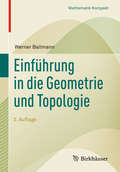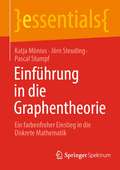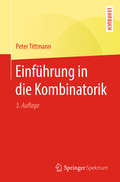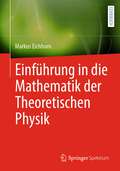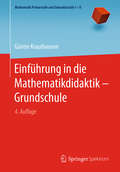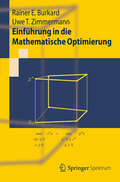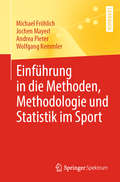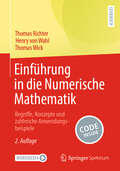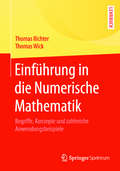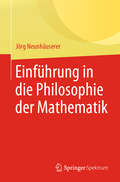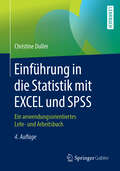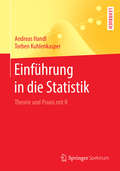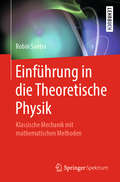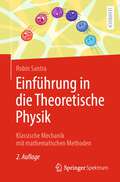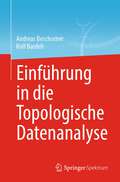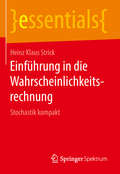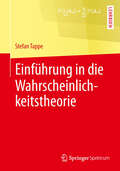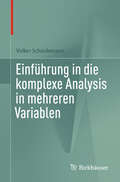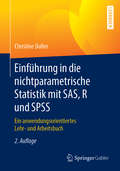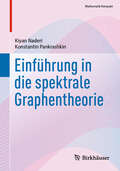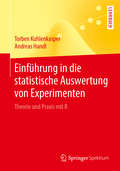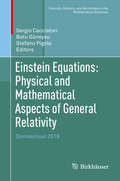- Table View
- List View
Einführung in die Geometrie und Topologie (Mathematik Kompakt)
by Werner BallmannDas Buch bietet eine Einführung in die Topologie, Differentialtopologie und Differentialgeometrie. Nach einer Einführung in grundlegende Begriffe und Resultate aus der mengentheoretischen Topologie wird der Jordansche Kurvensatz für Polygonzüge bewiesen und damit eine erste Idee davon vermittelt, welcher Art tiefere topologische Probleme sind. Im zweiten Kapitel werden Mannigfaltigkeiten und Liesche Gruppen eingeführt und an einer Reihe von Beispielen veranschaulicht. Diskutiert werden auch Tangential- und Vektorraumbündel, Differentiale, Vektorfelder und Liesche Klammern von Vektorfeldern. Weiter vertieft wird diese Diskussion im dritten Kapitel, in dem die de Rhamsche Kohomologie und das orientierte Integral eingeführt und der Brouwersche Fixpunktsatz, der Jordan-Brouwersche Zerlegungssatz und die Integralformel von Stokes bewiesen werden. Das abschließende vierte Kapitel ist den Grundlagen der Differentialgeometrie gewidmet. Entlang der Entwicklungslinien, die die Geometrie der Kurven und Untermannigfaltigkeiten in Euklidischen Räumen durchlaufen hat, werden Zusammenhänge und Krümmung, die zentralen Konzepte der Differentialgeometrie, diskutiert. Den Höhepunkt bilden die Gaussgleichungen, die Version des theorema egregium von Gauss für Untermannigfaltigkeiten beliebiger Dimension und Kodimension.In der zweiten Auflage habe ich eine Reihe von Textstellen leicht überarbeitet und einige Fehler berichtigt.
Einführung in die Graphentheorie: Ein farbenfroher Einstieg in die Diskrete Mathematik (essentials)
by Jörn Steuding Katja Mönius Pascal StumpfDieses essential liefert eine Einführung in die Graphentheorie; Vorkenntnisse werden dabei nicht benötigt. Ein Graph ist ein Gebilde bestehend aus Ecken und verbindenden Kanten. Wir untersuchen Kreise in Graphen (die jede Kante bzw. jede Ecke besuchen sollen), fragen uns, welche Graphen sich überschneidungsfrei zeichnen lassen, und schließlich machen wir uns an die Färbung von Graphen (wobei keine benachbarten Ecken mit derselben Farbe versehen werden sollen). Diese klassischen Themen der Graphentheorie werden durch eine Vielzahl von Illustrationen und einigen historischen Anmerkungen untermalt; motivierende Übungsaufgaben (mit Lösungen) und viele bunte Beispiele erleichtern den Einstieg in dieses aktuelle und vielseitige Gebiet der Mathematik.
Einführung in die Kombinatorik
by Peter TittmannDieses Lehrbuch vermittelt die Grundlagen und Konzepte der modernen Kombinatorik in anschaulicher Weise. Die verständliche Darlegung richtet sich an Studierende der Mathematik, der Naturwissenschaften, der Informatik und der Wirtschaftswissenschaften und erlaubt einen einfachen und beispielorientierten Zugang zu den Methoden der Kombinatorik. Beginnend mit den Grundaufgaben der Kombinatorik wird der Leser Schritt für Schritt mit weiterführenden Themen wie erzeugende Funktionen, Rekurrenzgleichungen und der Möbiusinversion sowie Graphenpolynomen und endlichen Automaten vertraut gemacht. Eine Vielzahl von Beispielen und Übungsaufgaben mit Lösungen erleichtern das Verständnis und dienen der Vertiefung und praktischen Anwendung des Lehrstoffes. Die vorliegende dritte Auflage ist komplett durchgesehen und deutlich erweitert um das Thema Kombinatorische Klassen und weitere, auch für die praktische Anwendung wichtige Graphenpolynome.
Einführung in die Mathematik der Theoretischen Physik
by Markus EichhornDieses Lehrbuch stellt die mathematischen Methoden der Theoretischen Physik detailliert und anschaulich dar. Das Hauptaugenmerk liegt dabei auf der verständlichen Herleitung und der Anwendbarkeit auf physikalische Probleme. Mathematische Herleitungen und Rechenkniffe werden Studierenden dabei in vielen Zwischenschritten zugänglich gemacht. Das Lehrbuch richtet sich primär an Studierende der ersten Semester, ist aber durch das gesamte Grundstudium hindurch und darüber hinaus als Referenz- und Nachschlagewerk geeignet. Darüber hinaus sind viele Beispiele für fortgeschrittene Studierende, wie der Formalismus der Allgemeinen Relativitätstheorie oder Lie-Algebren eingearbeitet. Am Ende jedes Kapitels befinden sich Formelsammlungen, die die Themen zusammenfassen und so einen kompakten Überblick über die einzelnen Zusammenhänge liefern.
Einführung in die Mathematikdidaktik – Grundschule
by Günter KrauthausenIn dieser Einführung in die Didaktik des Mathematikunterrichts der Primarstufe werden zunächst inhaltliche Grundlagen der drei Bereiche Arithmetik, Geometrie und Sachrechnen angesprochen. Zentrale Grundideen des Mathematiklernens wie etwa ein zeitgemäßes Verständnis von Lehren, Lernen und Üben, didaktische Prinzipien und allgemeine Ziele des Mathematikunterrichts werden dargestellt. Die Diskussion ausgewählter Aspekte der Organisation von Lernprozessen sowie klassischer Spannungsfelder des Mathematikunterrichts schließt sich an. Diese Aussagen sind in weiten Teilen auch auf die Sekundarstufe I übertragbar.Die vorliegende 4. Auflage wurde u. a. bezüglich der Bildungsstandards, einiger inhaltlicher Grundlagen und der Rolle von Lehrerinnen und Lehrern aktualisiert und in Teilen entsprechend neu strukturiert. Die Ausführungen werden durchgängig durch praxisnahe Beispiele aus Unterricht und Forschung konkretisiert. Dieser Band versteht sich als Arbeitsbuch: Hierzu sind Aufgaben für angehende Lehrerinnen und Lehrer sowie zahlreiche Literaturverweise gedacht.
Einführung in die Mathematische Optimierung
by Uwe T. Zimmermann Rainer E. BurkardMathematische Optimierung spielt aufgrund der verbreiteten Anwendung des Verfahrens und seiner raschen wissenschaftlichen Entwicklung eine wichtige Rolle im Mathematikstudium. In dem Buch führen die Autoren in die Lineare und Konvexe Optimierung ein und vermitteln darauf aufbauend Fragen der Diskreten und Nichtlinearen Optimierung. Vorausgesetzt werden nur Grundkenntnisse der Linearen Algebra und Analysis. Alle Verfahren werden anhand von ökonomischen Beispielen dargestellt, die einzelnen Schritte im Open-Source-Programm Scilab sind dokumentiert.
Einführung in die Methoden, Methodologie und Statistik im Sport
by Jochen Mayerl Michael Fröhlich Andrea Pieter Wolfgang KemmlerStudieren Sie Sportwissenschaft, sehen Sie Ihren Fokus in erster Linie in der praktischen Anwendung Ihres Wissens und sind wahrscheinlich überrascht, dass Sie sich in Ihrem Studium oder in einer weiteren Qualifikation nun erneut mit Mathematik und Statistik auseinandersetzen müssen. Haben Sie mit Schrecken festgestellt, dass Statistik auch hier zum unverzichtbaren Handwerkszeug gehört, will dieses Buch Sie motivieren, die Grundlagen der Methoden und der Statistik im Sport zu verstehen, Wissenslücken zu schließen und zu erkennen, dass empirisches Arbeiten keine Zauberei ist. Die Autoren vermitteln Hintergründe zur Verortung der Sportwissenschaft im wissenschaftlichen Kontext und erklären darauf aufbauend die Grundbegriffe und Arbeitsschritte bei der Durchführung, Auswertung und Beurteilung wissenschaftlicher Studien. Sie finden hier fundierte Tipps, wie Sie die richtige Forschungsfrage stellen, wie Sie Daten sammeln und aufbereiten, wann Sie welches statistische Verfahren rechnen und wie Sie die Standards guter wissenschaftlicher Praxis umsetzen können. Alle Ausführungen sind leicht verständlich formuliert und mit einer Vielzahl von realen Beispielen aus der Sportwissenschaft verdeutlicht. Dieses Buch bietet Ihnen eine gute Unterstützung, die empirischen Herausforderungen Ihres Studiums zu bewältigen - sei es beim Verstehen von Studien, sei es bei der Erstellung der ersten Hausarbeit mit echten Daten oder bei dem Verfassen Ihrer Abschlussarbeit.
Einführung in die Numerische Mathematik: Begriffe, Konzepte und zahlreiche Anwendungsbeispiele
by Thomas Richter Thomas Wick Henry von WahlDieses Lehrbuch behandelt zeitgemäß, anwendungsorientiert und ausführlich die theoretischen Grundlagen der Numerik. Dabei sind – zusätzlich zu den gängigen Inhalten – zahlreiche angewandte Beispiele und Praxis-Exkurse eingebunden, um das Verständnis nachhaltig zu fördern. Beweise werden sehr kleinteilig in vielen detailliert beschriebenen Schritten dargestellt. Auf die sich wiederholenden, zentralen Kernkonzepte der Numerik (z.B. Stabilität, Effizienz, Robustheit, Genauigkeit,…) wird explizit eingegangen, und diese Begriffe werden klar gegeneinander abgegrenzt. Außerdem werden Numerische Verfahren der Linearen Algebra und der Analysis getrennt dargestellt, was den Studierenden den Zugang zur Numerik – ausgehend von den beiden Grundvorlesungen des Mathematik-Studiums – deutlich erleichtert. Das Buch ist daher sowohl für Studierende der Mathematik als auch der Physik, der Informatik oder der Ingenieurwissenschaften bestens geeignet. Für die 2. Auflage wurde das Buch umfassend überarbeitet und erweitert. Unter anderem wurden Aspekte des maschinellen Lernens und neuronaler Netze aufgenommen, der Teil zu Krylow-Raum-Verfahren ausgebaut sowie angegebene Algorithmen durch konkrete Python-Codes ersetzt. Konkrete exemplarische Rechnungen werden nun auch mit diesen Python-Programmen durchgeführt.
Einführung in die Numerische Mathematik: Begriffe, Konzepte und zahlreiche Anwendungsbeispiele
by Thomas Richter Thomas WickDieses Lehrbuch behandelt zeitgemäß, anwendungsorientiert und ausführlich die theoretischen Grundlagen der Numerik. Dabei sind – zusätzlich zu den gängigen Inhalten – zahlreiche angewandte Beispiele und Praxis-Exkurse eingebunden, um das Verständnis nachhaltig zu fördern. Auf die sich wiederholenden, zentralen Kernkonzepte der Numerik (z.B. Stabilität, Effizienz, Robustheit, Genauigkeit,…) wird explizit eingegangen, und diese Begriffe werden klar gegeneinander abgegrenzt. Außerdem werden Numerische Verfahren der Linearen Algebra und der Analysis getrennt dargestellt, was den Studierenden den Zugang zur Numerik – ausgehend von den beiden Grundvorlesungen des Mathematik-Studiums – deutlich erleichtert.Das Buch ist daher sowohl für Studierende der Mathematik als auch der Physik, der Informatik oder der Ingenieurwissenschaften bestens geeignet.
Einführung in die Philosophie der Mathematik
by Jörg NeunhäusererWelche Art von Gegenständen untersucht die Mathematik und in welchem Sinne existieren diese Gegenstände? Warum dürfen wir die Aussagen der Mathematik zu unserem Wissen zählen und wie lassen sich diese Aussagen rechtfertigen? Eine Philosophie der Mathematik versucht solche Fragen zu beantworten. In dieser Einführung stellen wir maßgebliche Positionen in der Philosophie der Mathematik vor und formulieren die Essenz dieser Positionen in möglichst einfachen Thesen. Der Leser erfährt, auf welche Philosophen eine Position zurückgeht und in welchem historischen Kontext diese entstand. Ausgehend von Grundintuitionen und wissenschaftlichen Befunden lässt sich für oder gegen eine These in der Philosophie der Mathematik argumentieren. Solche Argumente bilden den zweiten Schwerpunkt dieses Buchs. Das Buch soll den Leser dazu anregen, über die Philosophie der Mathematik nachzudenken und eine eigene Position zu formulieren und für diese zu argumentieren.
Einführung in die Philosophie der Mathematik
by Jörg NeunhäusererWelche Art von Gegenständen untersucht die Mathematik und in welchem Sinne existieren diese Gegenstände? Warum dürfen wir die Aussagen der Mathematik zu unserem Wissen zählen und wie lassen sich diese Aussagen rechtfertigen? Eine Philosophie der Mathematik versucht solche Fragen zu beantworten. In dieser Einführung stellen wir maßgebliche Positionen in der Philosophie der Mathematik vor und formulieren die Essenz dieser Positionen in möglichst einfachen Thesen. Der Leser erfährt, auf welche Philosophen eine Position zurückgeht und in welchem historischen Kontext diese entstand. Ausgehend von Grundintuitionen und wissenschaftlichen Befunden lässt sich für oder gegen eine These in der Philosophie der Mathematik argumentieren. Solche Argumente bilden den zweiten Schwerpunkt dieses Buchs. Das Buch soll den Leser dazu anregen, über die Philosophie der Mathematik nachzudenken und eine eigene Position zu formulieren und für diese zu argumentieren. Die zweite Auflage ist vollständig durchgesehen und um ein Kapitel zum Idealismus ergänzt.
Einführung in die Statistik mit EXCEL und SPSS: Ein anwendungsorientiertes Lehr- und Arbeitsbuch
by Christine DullerDieses Lehrbuch führt leicht verständlich und anwendungsorientiert in die beschreibende und schließende Statistik sowie in die Wahrscheinlichkeitsrechnung ein:Die Methoden der Statistik werden nicht nur beschrieben, sondern auch in EXCEL und SPSS umgesetzt.Zahlreiche Beispiele mit Lösungen ergänzen die Darstellung, daher ist das Buch auch für das Selbststudium gut geeignet.Wesentliche Aspekte sind übersichtlich zusammengefasst, um das Lernen zu erleichtern und ein schnelles Nachschlagen zu ermöglichen.In der vierten Auflage wurden inhaltliche Ergänzungen (Boxplots und Fisher-Test) vorgenommen und die Software-bezogenen Inhalte an die jeweils aktuellen Versionen angepasst (IBM SPSS Statistics 25, Microsoft EXCEL 2019).
Einführung in die Statistik: Theorie und Praxis mit R
by Andreas Handl Torben KuhlenkasperDieses Lehrbuch motiviert und erklärt die Inhalte der deskriptiven und induktiven Statistik, indem es die mathematischen Grundlagen der Statistik mit vielfältigen, leicht nachvollziehbaren Anwendungen und Beispielen verbindet: Durch überschaubare Beispiele, die mit Papier und Stift durchgerechnet werden können (und sollten!) gewinnt der Leser zunächst Verständnis und einen routinierten Umgang mit den zentralen Formeln. Für größere Beispiele kommt das frei verfügbare statistische Software R zum Einsatz, welches die Berechnungen schnell und verlässlich auch für große Datensätze umsetzt.
Einführung in die Theoretische Physik: Klassische Mechanik mit mathematischen Methoden
by Robin SantraDieses Lehrbuch bietet Studierenden der ersten Semester eine Einführung in die Theoretische Physik sowie die dazu erforderlichen mathematischen Werkzeuge. Parallel zu den Inhalten der Klassischen Mechanik lernen Sie die nötige Mathematik gleich mit – und auch die Denkweise in der Theoretischen Physik kennen. Unter sorgfältiger Berücksichtigung des Wissensstands von Studienanfängern wird eine ausführliche, schrittweise Darstellung von allen Herleitungen und Beispielen geboten. Dabei werden Ihnen nicht nur die analytischen Lösungsverfahren gezeigt, sondern Sie erhalten auch einen Einblick in die große Bedeutung von computergestützten, numerischen Verfahren. Das Buch beginnt mit den Leitbegriffen des Zustands und der Bewegungsgleichung, worauf aufbauend die Struktur der Newton‘schen Mechanik in leicht nachvollziehbarer Art und Weise vermittelt wird. Als dazugehörige mathematische Themen werden komplexe Zahlen, Vektoren und Matrizen, Taylor-Reihen, gewöhnliche Differentialgleichungen, Fourier-Reihen, partielle Ableitungen und Elemente der Vektoranalysis behandelt. Ebenso finden Sie in diesem Buch eine Untersuchung elementarer Erhaltungssätze als auch deren Anwendung auf physikalische Fragestellungen wie z.B. die Begründung der Kepler‘schen Gesetze.
Einführung in die Theoretische Physik: Klassische Mechanik mit mathematischen Methoden
by Robin SantraDieses Lehrbuch bietet Studierenden der ersten Semester eine Einführung in die Theoretische Physik sowie die dazu erforderlichen mathematischen Werkzeuge. Parallel zu den Inhalten der Klassischen Mechanik lernen Sie die nötige Mathematik gleich mit – und auch die Denkweise in der Theoretischen Physik kennen. Unter sorgfältiger Berücksichtigung des Wissensstands von Studienanfängern wird eine ausführliche, schrittweise Darstellung von allen Herleitungen und Beispielen geboten. Dabei werden Ihnen nicht nur die analytischen Lösungsverfahren gezeigt, sondern Sie erhalten auch einen Einblick in die große Bedeutung von computergestützten, numerischen Verfahren. Das Buch beginnt mit den Leitbegriffen des Zustands und der Bewegungsgleichung, worauf aufbauend die Struktur der Newton‘schen Mechanik in leicht nachvollziehbarer Art und Weise vermittelt wird. Als dazugehörige mathematische Themen werden komplexe Zahlen, Vektoren und Matrizen, Taylor-Reihen, gewöhnliche Differenzialgleichungen, Fourier-Reihen, partielle Ableitungen und Elemente der Vektoranalysis behandelt. Ebenso finden Sie in diesem Buch eine Untersuchung elementarer Erhaltungssätze als auch deren Anwendung auf physikalische Fragestellungen wie z.B. die Begründung der Kepler‘schen Gesetze.
Einführung in die Topologische Datenanalyse
by Andreas Beschorner Rolf BardeliDer Einstieg in die Topologische Datenanalysis (TDA) fällt oft nicht leicht, da sie auf der Algebraischen Topologie beruht, einem Gebiet der reinen Mathematik. Mit dieser Einleitung wollen wir Interessierte (Studierende, Data Scientists, aber auch Mathematiker:innen) an die Hand nehmen, indem wir die primär notwendigen Grundlagen dieses komplexen Bereichs der Mathematik zur Verfügung stellen. Dies geschieht vor allem im Hinblick auf Anwendbarkeit in der Datenanalyse, welcher sich dann die späteren Kapitel des Buches widmen. So hoffen wir, sowohl Informatikern und praktizierenden Data Scientists den eher theoretischen Aspekt, sowie Mathematikern den praktischen, anwendungsorientierten Anteil näher bringen zu können. Dazu werden für wichtige Beispiele Bibliotheken (Python) vorgestellt und Pseudocode oder kleine Jupyter-Notebooks zur Verfügung gestellt. Auch Aspekte der Laufzeit werden, wo relevant, angesprochen. Das alles geschieht im theoretischen Umfeld der Mathematik, so dass die zwei Seiten der TDA, Informatik und Mathematik, ihr Miteinander finden.
Einführung in die Wahrscheinlichkeitsrechnung: Stochastik kompakt (essentials)
by Heinz Klaus StrickIn diesem ersten Teil von Stochastik kompakt erläutert Heinz Klaus Strick die Grundbegriffe, die im Zusammenhang mit den Themen aus Wahrscheinlichkeitsrechnung und Statistik eine Rolle spielen. Mithilfe der Rechenregeln für Wahrscheinlichkeiten können dann einfache Wahrscheinlichkeitsverteilungen einschließlich der zugehörigen Erwartungswerte bestimmt werden. Am Ende steht die Untersuchung der Eigenschaften von Binomialverteilungen. Der Autor Heinz Klaus Strick war 37 Jahre lang als Lehrer für Mathematik und Physik an einem Gymnasium in Leverkusen tätig. Durch seine fachdidaktischen Aufsätze, Schulbücher, Vorträge und Lehraufträge an verschiedenen Universitäten wurde er bekannt. Für seine Aktivitäten und insbesondere für seine Anregungen zum Stochastikunterricht wurde ihm 2002 der Archimedes-Preis der MNU verliehen.
Einführung in die Wahrscheinlichkeitstheorie
by Stefan TappeEine Vorlesung zur Einführung in die Wahrscheinlichkeitstheorie gehört - neben den Standardvorlesungen Analysis und Lineare Algebra - zur Grundausbildung eines jeden Mathematikers. Vielen Studierenden bereitet der Umgang mit dem "Zufall" Schwierigkeiten. Das Ziel des vorliegenden Buches ist, eine leicht lesbare und gründliche Einführung in die Wahrscheinlichkeitstheorie zu bieten; eine Vielzahl von anschaulichen und sorgfältig ausgewählten Beispielen soll den Studierenden helfen, den Zufall in den Griff zu bekommen. Dabei ist dem Autor eine klare und vollständige Darstellung der Theorie ebenso wichtig wie Beispiele und Abbildungen, die schwer aussehende Sachverhalte verdeutlichen. In zahlreichen Abbildungen und in über 100 Beispielen wird die Theorie illustriert und in verständlichen Worten formuliert. Der Inhalt des Buches ist klassisch und deckt eine erste Einführung in die Wahrscheinlichkeitstheorie - der Theorie des Zufalls - ab.
Einführung in die komplexe Analysis in mehreren Variablen
by Volker ScheidemannDieses Buch gibt eine umfassende Einführung in die komplexe Analysis in mehreren Variablen. Während es sich auf eine Reihe von Themen der komplexen Analysis konzentriert, anstatt zu versuchen, so viel Material wie möglich abzudecken, werden Verweise auf andere Teile der Mathematik wie die Funktionalanalysis oder Algebren gemacht, um die Sichtweise und das Verständnis der gewählten Themen zu erweitern. Ein Hauptaugenmerk liegt auf Fortsetzungsphänomenen, die der eindimensionalen Theorie fremd sind und im berühmten Hartog'schen Kugelsatz, dem Satz von Cartan-Thullen und dem Satz von Bochner zum Ausdruck kommen.Das Buch richtet sich in erster Linie an Studenten, die beginnen, auf dem Gebiet der komplexen Analysis in mehreren Variablen zu arbeiten, und an Dozenten, die einen Kurs vorbereiten. Zu diesem Zweck sind zahlreiche Beispiele und unterstützende Übungen im gesamten Text enthalten.Diese zweite Auflage enthält Hinweise und Vorschläge fürdie Lösung der gestellten Aufgaben, mit verschiedenen Graden der Unterstützung.
Einführung in die nichtparametrische Statistik mit SAS, R und SPSS: Ein anwendungsorientiertes Lehr- und Arbeitsbuch
by Christine DullerChristine Duller gibt in diesem Buch eine leicht verständliche Einführung in die nichtparametrische Statistik. Dabei beschreibt sie nicht nur die statistischen Verfahren, sondern setzt diese auch in SAS und R um. Beide Programmiersprachen stellt die Autorin kurz vor, sodass keine Vorkenntnisse notwendig sind. Das Buch eignet sich besonders für Studierende der Wirtschafts- und Sozialwissenschaften und alle Interessierten, die (nur) über Grundkenntnisse der Statistik verfügen, aber auch als Nachschlagewerk für einfache statistische Analysen.
Einführung in die spektrale Graphentheorie (Mathematik Kompakt)
by Kiyan Naderi Konstantin PankrashkinDieses Buch bietet eine Einführung in die wichtigsten Fragestellungen in der spektralen Graphentheorie. In der spektralen Graphentheorie untersucht man verschiedene Eigenschaften von Graphen mit den Methoden der linearen Algebra, insbesondere mittels der Eigenwerte und der Eigenvektoren verschiedener Matrizen, die die Graphenstruktur beschreiben. Diverse Aspekte der Graphentheorie finden eine Anwendung im Rahmen der Data Science. In diesem Buch werden die notwendigen Grundlagen aus der abstrakten Graphentheorie sowie aus dem Gebiet der linearen Algebra parallel behandelt, sodass sich das Buch auch für Studierende der ersten Semester eignet. Das Buch wurde mehrmals in einer Semestervorlesung erprobt und eignet sich daher als Vorlesungsmanuskript und Aufgabensammlung für Lehrende.
Einführung in die statistische Auswertung von Experimenten: Theorie und Praxis mit R
by Andreas Handl Torben KuhlenkasperDieses Lehrbuch stellt eine Vielzahl von Werkzeugen zur Analyse von Experimenten zur Verfügung: Es zeigt die Grundlagen der Auswertung faktorieller Versuchspläne mittels ein- oder mehrfaktorieller Varianzanalysen (ANOVA) sowie mittels gängiger nichtparametrischer Alternativen. Darüber hinaus werden auch Verfahren zur Überprüfung der Annahmen von Varianzanalysen vorgestellt.Die einzelnen Verfahren werden zunächst anhand übersichtlicher Beispiele und Datensätze motiviert, vorgestellt und mit Papier und Stift durchgerechnet. Für größere Beispiele kommt die frei verfügbare statistische Software R zum Einsatz, mit der die manuellen Berechnungen nachvollzogen und schließlich auch größere Datensätze ausgewertet werden können.
Eins, zwei, viele: Eine Kulturgeschichte des Zählens
by Mario H. KrausDieses Werk gibt einen Überblick über die Geschichte des Zählens, sowohl in mathematischen oder philosophischen als auch soziokulturellen Zusammenhängen. Die Frage "Warum und wie zählen wir eigentlich?" wird vielfältig untersucht und beantwortet. Bewusst kurz und unterhaltsam soll das Buch auch Anwendungen zeigen - im Alltag, in der Wissenschaft oder bei Volkszählungen und in der Stadtentwicklung.
Einsatz überwachender Technologien bei Demenz (Gesundheit. Politik - Gesellschaft - Wirtschaft)
by Jasmin LehmannDie zunehmende Technisierung von Alter und Pflege ist nicht nur mit Chancen, sondern auch mit zahlreichen Gefahren verbunden. Selbst vor dem Hintergrund des demografischen Wandels und der damit verbundenen Herausforderungen ist die Integration technischer Innovationen ins Pflegesystem nicht selbstverständlich als erstrebenswert zu erachten. Vielmehr ist der sowohl hierzulande als auch international zur Bewältigung der Herausforderungen eingeschlagene Weg auf seine ethische Legitimation hin zu überprüfen. Ethische Fragen stellen sich insbesondere in Zusammenhang mit dem Einsatz überwachender Technik bei Demenz. Zum einen weisen Betroffene eine erhöhte Vulnerabilität auf, zum anderen kann ihre Entscheidungsfähigkeit in unterschiedlichem Maße beeinträchtigt sein. Mitunter erfolgt elektronische Überwachung bei Demenz auch ohne eine informierte Zustimmung der betroffenen Person. In dieser Arbeit werden auf Basis einer qualitativen Untersuchung zum Einsatz überwachender Technologien bei Demenz ethische, rechtliche und soziale Fragen aufgegriffen und diskutiert. Die Ergebnisse zeigen, dass sich elektronische Überwachung prinzipiell positiv auf die Lebensqualität Betroffener auswirken kann. Dies heißt aber keineswegs, dass es in jedem Fall dazu kommt. Ausschlaggebend sind die Gegebenheiten des Einzelfalls, die es durch fachliche bzw. ethische Standards zu gestalten gilt.
Einstein Equations: Domoschool 2018 (Tutorials, Schools, and Workshops in the Mathematical Sciences)
by Sergio Cacciatori Batu Güneysu Stefano PigolaThis book is based on lectures given at the first edition of the Domoschool, the International Alpine School in Mathematics and Physics, held in Domodossola, Italy, in July 2018. It is divided into two parts. Part I consists of four sets of lecture notes. These are extended versions of lectures given at the Domoschool, written by well-known experts in mathematics and physics related to General Relativity. Part II collects talks by selected participants, focusing on research related to General Relativity.
